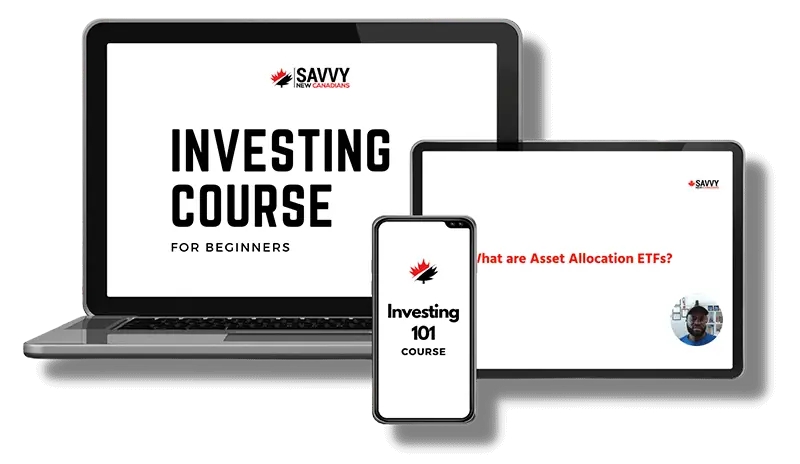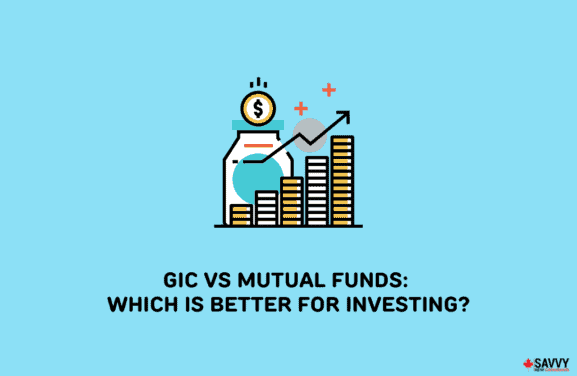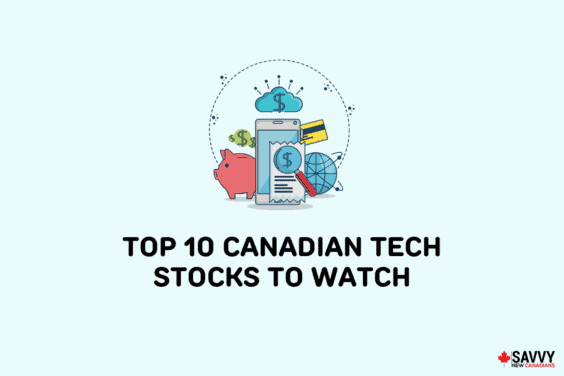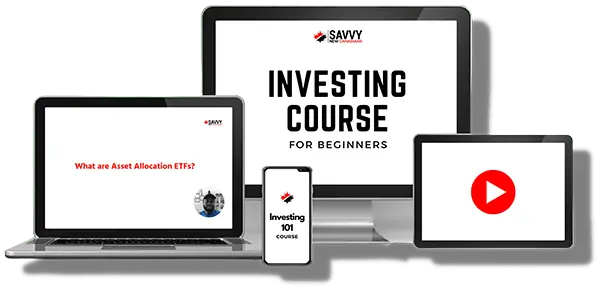This article summarizes the best investment accounts in Canada and the investment products you can buy.
Many will agree that investing is important if you want to grow your net worth, meet your financial goals and reach financial independence.
While there are all kinds of investment accounts and products available in Canada, the very idea of investing your money can feel overwhelming for beginners.
What to invest in – mutual funds, stocks, ETFs, bonds, real estate? The investment accounts to use – TFSA, RRSP, RESP? How to maximize your returns and save on investment fees and taxes? And, how to not lose your money…
Investing is about the future of your money, and it can generate questions and fears.
Whether you are a newcomer to Canada or have lived here all your life, if you are just starting out on your investment journey in Canada, this article is for you.
We cover the basic investment accounts and when to use them, the common types of investments you can add to your portfolio, and how to invest confidently.
Investment Accounts in Canada
Broadly speaking, there are registered and non-registered investment accounts.
Government-registered accounts offer investors opportunities to save on taxes while growing their accounts. The most common registered investment accounts in Canada include:
- Registered Retirement Savings Plan (RRSP)
- Tax-Free Savings Plan (TFSA)
- Registered Education Savings Plan (RESP)
The tax savings offered by these plans work in different ways.
For example, in the case of an RRSP, your contributions are tax-deductible, and no tax is paid on your portfolio returns. When you start withdrawing income later down the road, the funds are taxed at your marginal tax rate. This is a classic case of tax deferral.
For the TFSA, your contributions are made using after-tax income; however, no tax is levied on the earnings in your portfolio, and no tax is due when you withdraw. This is why the account is called a “tax-free” plan.
Registered accounts must follow specific government rules to maintain their tax-free or tax-deferred status, and there’s a limit to how much you can contribute.
Non-registered investment accounts, on the other hand, do not offer tax deferrals on earnings. However, they are more flexible and offer specific advantages, including the ability to offset capital losses with gains.
There are many factors to consider when deciding between registered vs. non-registered investments. Learn more about what to consider here.

Registered Investment Accounts in Canada
While there is a place for having non-registered investments, beginner investors should generally first focus on maxing out their registered accounts.
Registered Retirement Savings Plan (RRSP)
The RRSP was designed with retirement savings in mind. Each year, you can contribute up to 18% of your previous year’s income up to a maximum limit.
For the 2024 tax year, the maximum RRSP contribution limit is $31,560. Unused contribution room can be carried forward to future years, and you can continue to make contributions until when you turn 71.
Contributions to your RRSP account are tax-deductible, resulting in lower taxes each year you make a contribution.
As an example, if your marginal tax rate is 30% and you contribute $10,000 to your RRSP, you can claim a tax deduction at tax time and save $3,000 in taxes (i.e. $10,000 x 30%).
Earnings on your RRSP account (capital gains, interest income, and dividends) continue to grow “tax-free” until you start making withdrawals.
In addition to saving for retirement, the government allows tax-free withdrawals from your RRSP to pay for a home (Home Buyers’ Plan) or to fund your post-secondary education (Lifelong Learning Plan).
At age 71, you must close your RRSP account and can convert it into a Registered Retirement Income Fund (RRIF).
Related reading:
Tax-Free Savings Account (TFSA)
Residents of Canada who are at least 18 years of age or older can contribute to a Tax-Free Savings Account and pay no taxes on earnings (interest, capital gains, dividends) or withdrawals.
A TFSA contribution limit is announced every year. For 2023, it was $6,500, and for 2023, it is $7,000. If you have been eligible to contribute since 2009, when this program started, your total TFSA contribution room is now $95,000 in 2024.
You can carry forward unused contribution room indefinitely. Unlike the RRSP, if you withdraw from your TFSA, you can re-contribute it in future years.
TFSAs can be used to invest towards any savings goal (short or long-term), including a home down payment, vacation, car purchase, or retirement.
There are penalties when you over-contribute to a TFSA or use prohibited or non-qualified investments.
Related reading:
Registered Education Savings Plan (RESP)
Parents can use an RESP to save for their child’s post-secondary education. You can contribute up to $50,000 to the account per child and use an individual or family RESP account.
Benefits of a Registered Education Savings Plan include tax-free growth and later taxation (at 0% or a very low tax rate) in the hands of your child when they withdraw funds to pay for school.
In addition, the government matches your RESP contributions at a rate of 20 cents per $1 (20%) up to $500 per year through the Canada Education Savings Grant (CESG). Low-to-moderate income families may be eligible for extra government grants through the additional CESG and Canada Learning Bond (CLB).
Grant money is available until your child turns 18. A child can get up to $7,200 in maximum CESG benefits and up to $2,000 in CLB benefits.
Related reading:
Other registered investment accounts in Canada are:
- Registered Retirement Income Fund
- Life Income Fund (LIF)
- Locked-In Retirement Savings Plan
Non-Registered Investment Accounts
If you have maxed out your registered accounts and have additional funds to invest, a non-registered account is definitely worth checking out.
There is no age or contribution limit for non-registered accounts, which makes them usable under most scenarios.
The general types of non-registered accounts are:
Cash Account: You can use this basic account to purchase investments using the cash available in your account at the time of the transaction.
Margin Accounts: This account allows an investor to purchase additional investments using borrowed funds from your broker. This leverage is possible by allowing you to borrow funds against the value of your existing investments.
Borrowing funds to invest is risky and can amplify your losses when the market goes against your position. You also pay interest on the borrowed funds. A margin account gives you the ability to use short-selling and trade options.
Cash or margin accounts can either be opened as individual, joint or corporate accounts.
Investment Options in Canada
There are many investment types you can choose from depending on your financial goals, investment risk tolerance, and experience.
While some assets are listed, they may not be suitable for beginners, and you should exercise caution. Examples include options, commodities, and cryptocurrencies.
Stocks
When you buy shares in a company, you are said to own “stock” in it. This “share” ownership means you own a small or large portion of a company, and you are entitled to some of its profits paid out in the form of dividends.
In addition to profit-sharing (dividends), when you sell a stock at a higher price than you paid for it, you enjoy capital gains.
As a shareholder, you get voting rights to choose the Board of Directors and approve some changes before they can be implemented.
Stocks are also referred to as “equities,” and the two main types of stocks are common stocks and preferred stocks.
Stocks are traded on a stock exchange, and you can purchase them directly using a discount brokerage platform such as Questrade or Wealthsimple Trade.
You can also own stocks as part of a mutual fund or ETF. Stocks are a higher-risk investment. In exchange for the risk you assume when you purchase them, you expect stocks to provide you with a higher return.
Related: How to Evaluate a Stock.
Bonds
A bond is a loan to a business or government, resulting in interest income being paid to the lender or bondholder.
When you purchase a bond, you are effectively lending money out with an expectation that your principal will be paid back after some time plus interest.
Bonds vary in risk levels depending on the credit rating of the borrower. A lower-quality bond pays a higher interest rate to compensate the lender for assuming additional risk.
The various types of bonds include corporate bonds, federal government bonds (Treasuries), provincial bonds, and municipal bonds.
Bonds are generally lower risk than stocks. To buy them, use a brokerage platform or purchase them through ETF or mutual fund holdings.
Exchange-Traded Funds (ETFs)
An ETF is a basket of investments, such as stocks, bonds or commodities, held together as one asset.
They are traded on exchanges similar to stocks and offer investors access to diversified investment portfolios without needing to buy each one individually.
The diversification and risk reduction provided by ETFs cannot be overstated. One single ETF makes you a fractional proud owner of thousands of stocks.
ETFs are generally cheaper than traditional funds, and in the long run, lower fees can improve your returns.
When you sell your ETF holding at a higher price than what you paid for it, you generate a capital gain. Your portfolio can also increase in value from cash, dividends, and interest distributions.
You can purchase ETFs on a brokerage platform such as Wealthsimple Trade or via a robo-advisor like Wealthsimple.
All-in-One ETF Portfolios
All-in-one ETF portfolios are even easier options for new investors. They remove the need for rebalancing and require little to no ongoing management on your part.
A good example is Vanguard’s Growth ETF Portfolio (VGRO).
Related reading:
Mutual Funds
A mutual fund is a pool of investments (such as bonds or stocks) that investors can buy into.
Traditional mutual funds are actively managed by a portfolio manager, and they charge a fee referred to as the Management Expense Ratio (MER). Mutual funds are generally more expensive than ETFs.
You can purchase a mutual fund through your bank, credit union, or broker. Your mutual fund portfolio will vary in risk depending on whether it is a conservative, balanced, or growth portfolio.
Learn more about mutual funds.
High-Interest Savings and GICs
Cash is one other asset you can hold in your investment account.
The reason for holding cash could be that you are saving towards a short-term goal and can’t afford to lose any portion of your capital and/or you could simply be risk-averse.
A high-interest savings account can be held in a TFSA or RRSP. You can also use a Guaranteed Investment Certificate (GIC) that guarantees your principal and the interest it will earn over a period of time.
The interest rate on savings and term deposits is significantly lower than what you could potentially earn by investing in the stock markets.
However, they have minimal risks and are insured by CDIC up to $100,000 or by provincial deposit insurance corporations.
Related reading:
- Safest Investments in Canada
- Best Savings Accounts in Canada
- Best GIC rates in Canada
- EQ Bank Hybrid Savings Account
- Neo Financial High Interest Savings
There are other investment assets available to investors, including:
- Real Estate via Real Estate Investment Trusts (REITs), Mortgage Investment Corporations, and syndicated mortgages
- Commodities including precious metals, agricultural commodities, oil and gas
- Options and other financial derivatives
- Cryptocurrencies
- Peer-to-Peer Lending
- Private Equity
- Hedge funds
Learn more about alternative investments in Canada.

How To Invest in Canada
Now that we have covered the different types of investment accounts and products, how can you get started?
New investors often default to their bank for all or most of their financial transactions, including investments. This tendency can cost you lots of money in fees or poor interest rates on savings deposits.
My preferred choices for investment providers are robo-advisors or discount brokers.
1. Robo-Advisor
A robo-advisor is an online wealth management service that invests money on your behalf using low-cost ETFs.
The best robo-advisors in Canada follow a passive investing strategy that has been shown to beat active investing time and again.
Robo-advisors are great for beginners because they do all the heavy lifting for you. They assess your risk tolerance upfront and recommend a suitable investment portfolio that meets your needs.
Your funds are automatically invested and rebalanced as needed. You also get free financial advice.
One other main highlight of robo-advisors compared to a traditional financial advisor and mutual funds is that you pay a much lower management fee, e.g. with Questwealth, you end up paying between 0.45% and 0.55% per year versus 2% or more for a comparable equity mutual fund.
Robo-advisor platforms can easily be accessed from the comfort of your home using a computer, tablet, or smartphone.
Lastly, robo-advisors have low or no minimum account requirements. With Questwealth, you can start investing with as little as $1,000 and set up regular pre-authorized contributions.
Questwealth is Canada’s lowest-cost robo-advisor. Open an account here to invest up to $10,000 free of charge for 1 year.
2. Discount Brokerage
A discount broker offers an online platform where investors can buy and sell financial products, including stocks, bonds, ETFs, mutual funds, and more.
The best online discount brokerage platforms in Canada offer low- or no-commission trading and can save you a ton of money in fees.
This do-it-yourself approach, however, requires that you put in a little bit of work as you will need to decide what assets to buy or sell, how many, at what price, and how often.
You will also need to rebalance your portfolio a few times per year to keep its composition in line with your risk tolerance.
Questrade is Canada’s premier discount broker. It offers $0 commission ETF purchases and low trading fees for other products (options, bonds, FX, mutual funds, GICs, etc.)
Investors can also choose to go with a full-service broker to access financial advice and support. In this case, you pay higher fees.
Open a Questrade account and get $50 in free trades when you fund your account with $1,000 or more.
You can also check out the Wealthsimple Trade App for commission-free stock and ETF trading. Wealthsimple Trade is the only brokerage platform in Canada you can use for fractional share trades.
Open a Wealthsimple Trade account and get a $25 bonus when you deposit at least $200 within 45 days of registering your account
Related:
3. Micro-Investing Apps
What if you simply can’t afford to set aside money to invest? Don’t give up yet; a micro-investing app can help you get started.
Micro-investing apps, also known as spare change investing apps, round up your credit and debit card purchases and invest the difference. For example, if you buy a burger for $10.25, the app rounds up your spending to $11 and invests $0.75.
These apps can also help you to invest larger lump sums or contributions.
The most popular spare change app in Canada is Moka. It costs $3 per month in fees, and you can use it to invest in a TFSA, RRSP, or non-registered investment account.
One downside to these apps is that the $3/month is high if all you do is invest the odd cents and dollars. If you are a Wealthsimple client, their app also offers roundup investment capabilities.
Related: Moka Investing App review
Rules of Investing
Before investing, you should be aware of some rules that lead to successful investing.
An understanding of the relationship between risk and reward is important. In general, the higher the risk, the higher the potential returns. This risk-return trade-off highlights the need to match your risk tolerance with your return expectations.
“Never put all your eggs in one basket.” Allocate your investments to cover various asset classes, industries, and geographical locations, so you are not overly exposed to unsystematic or diversifiable risk. A robo-advisor can help you accomplish this automatically.
Compounding interest is a beautiful thing. If you start investing early, you can harness the power of compound interest to grow your portfolio beyond your wildest imagination.
A few years back, I wrote this article on the golden rules of investing that I follow. They are as applicable as ever. Here’s a summary:
- Invest only in what you understand
- Cut your investment fees
- Always be diversified
- Invest with a long-term mentality
- Maximize your tax-sheltered accounts
- Rebalance your portfolio annually
- Keep an emergency fund
- Invest in yourself








Thanks for this great information and eye opening info. Pls how about investment in Nigeria. There some companies rising up now advertising 15% on every money from 350,000 naira u invest in their company. Can u pls give advise on nigeria investors. Thanks my email is… will appreciate ur reply.
@Folasade: I haven’t been closely following the investment products and opportunities in Nigeria for a while. That said, any offer of 15% at this point in time is likely a very risky/aggressive portfolio with holdings in either cryptocurrencies or some other volatile asset. I wouldn’t advise anyone to put their money in it…unless you fully understand what they are investing in and/or you can afford to lose 100% of your investment.
Hi Enoch, very interesting topic, do you know if theres any kind of investment i can make to get 5% of return monthly?
@Arturo: I am not familiar with any.